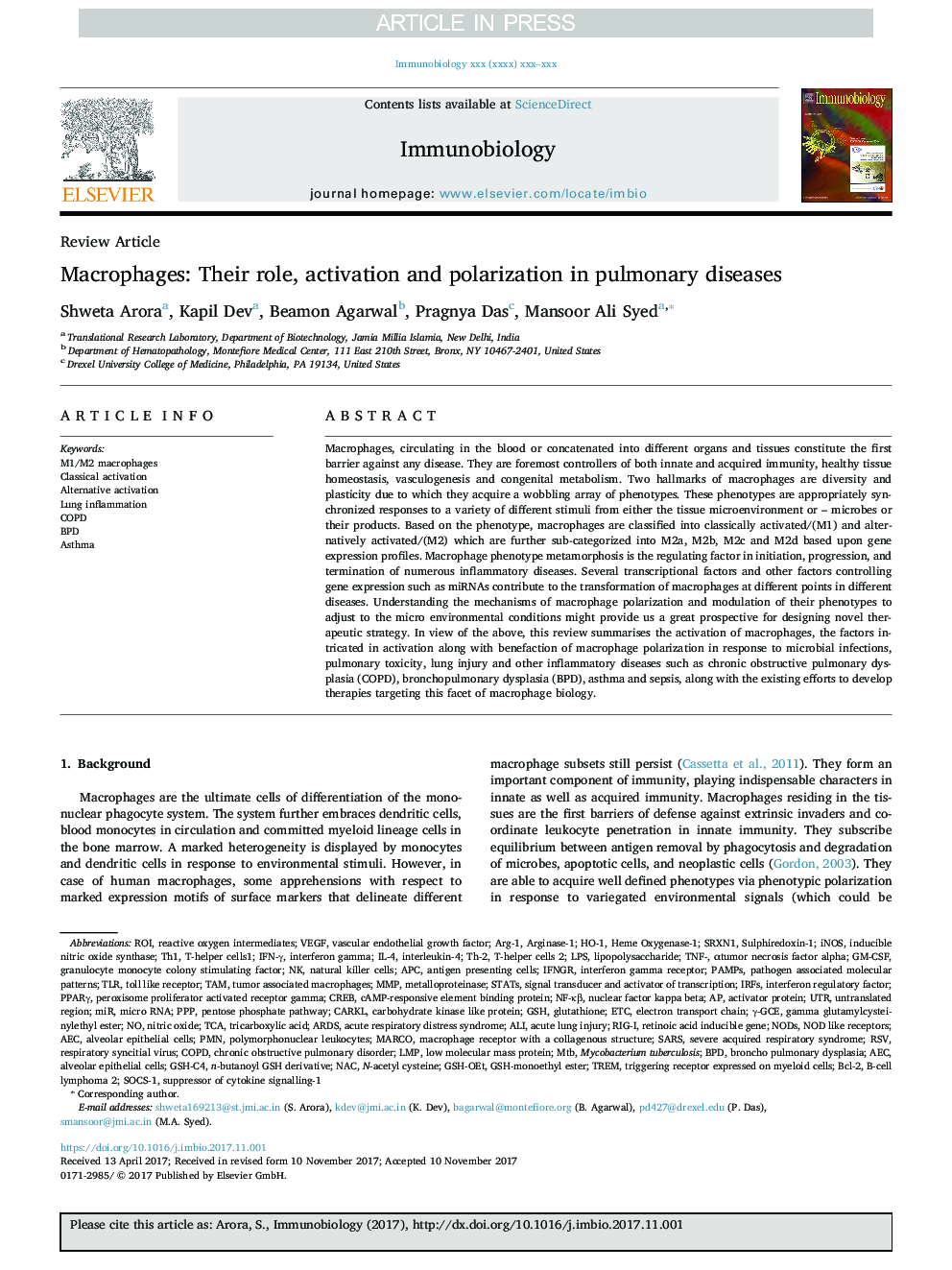| Article ID | Journal | Published Year | Pages | File Type |
|---|---|---|---|---|
| 8472040 | Immunobiology | 2018 | 14 Pages |
Abstract
Macrophages, circulating in the blood or concatenated into different organs and tissues constitute the first barrier against any disease. They are foremost controllers of both innate and acquired immunity, healthy tissue homeostasis, vasculogenesis and congenital metabolism. Two hallmarks of macrophages are diversity and plasticity due to which they acquire a wobbling array of phenotypes. These phenotypes are appropriately synchronized responses to a variety of different stimuli from either the tissue microenvironment or - microbes or their products. Based on the phenotype, macrophages are classified into classically activated/(M1) and alternatively activated/(M2) which are further sub-categorized into M2a, M2b, M2c and M2d based upon gene expression profiles. Macrophage phenotype metamorphosis is the regulating factor in initiation, progression, and termination of numerous inflammatory diseases. Several transcriptional factors and other factors controlling gene expression such as miRNAs contribute to the transformation of macrophages at different points in different diseases. Understanding the mechanisms of macrophage polarization and modulation of their phenotypes to adjust to the micro environmental conditions might provide us a great prospective for designing novel therapeutic strategy. In view of the above, this review summarises the activation of macrophages, the factors intricated in activation along with benefaction of macrophage polarization in response to microbial infections, pulmonary toxicity, lung injury and other inflammatory diseases such as chronic obstructive pulmonary dysplasia (COPD), bronchopulmonary dysplasia (BPD), asthma and sepsis, along with the existing efforts to develop therapies targeting this facet of macrophage biology.
Keywords
TNF-PPARγAPCLMPBPDIFN-γTLRCREBHeme oxygenase-1PMNARDSMTBRSVAECGM-CSFRIG-IIFNGRSOCS-1NF-κβTh1MARCOTh-2ARG-1M1/M2 macrophagesNod like receptorsIRFsgranulocyte monocyte colony stimulating factorSRXN1MMPiNOSTCAIL-4GSHNACHO-1PPPPAMPsROIBcl-2LPSMIRmicro RNASTATsArginase-1AsthmaAcute lung injuryAntigen presenting cellsNodschronic obstructive pulmonary disordertricarboxylic acidLung inflammationAliinterleukin-4COPDTAMtoll like receptorTumor associated macrophageselectron transport chainSARSalveolar epithelial cellsNatural killer cellsinducible nitric oxide synthaseAcute respiratory distress syndromeinterferon regulatory factorVascular endothelial growth factorVascular Endothelial Growth Factor (VEGF)nuclear factor kappa betaAlternative activationClassical activationTREMB-cell lymphoma 2polymorphonuclear leukocyteslipopolysaccharideMycobacterium tuberculosisSignal transducer and activator of transcriptionMetalloproteinasepentose phosphate pathwayUTR یا untranslated regions untranslated regionNitric oxideN-acetyl cysteineETcReactive oxygen intermediatesRespiratory syncitial viruspathogen associated molecular patternscAMP-responsive element binding proteinactivator proteinInterferon gammaGlutathionetriggering receptor expressed on myeloid cellsInterferon gamma receptorPeroxisome proliferator activated receptor gamma
Related Topics
Life Sciences
Biochemistry, Genetics and Molecular Biology
Cell Biology
Authors
Shweta Arora, Kapil Dev, Beamon Agarwal, Pragnya Das, Mansoor Ali Syed,
